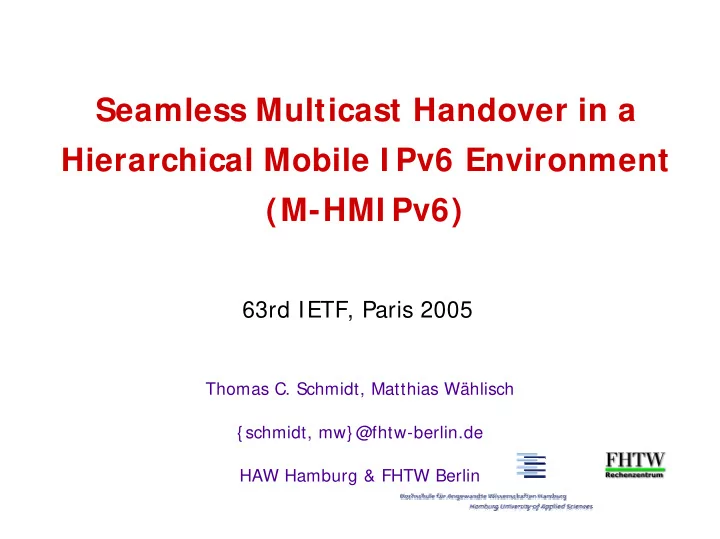

Seamless Multicast Handover in a Hierarchical Mobile I Pv6 Environment (M-HMI Pv6) 63rd IETF, Paris 2005 Thomas C. Schmidt, Matthias Wählisch { schmidt, mw} @fhtw-berlin.de HAW Hamburg & FHTW Berlin
Outline � Problem Statement � Why start from HMIPv6? � M-HMIPv6 � Conclusions & Outlook
The Problem: Mobile Multicast ! Mcast in low bandwidth mobile environments ! Seamless data service for multimedia streams o Mcast applications source address aware (HoA) o Routing: asymmetric, slow convergence - up to ≈ 30 s at listener - up to ≈ 3 min at sender - Routing source address dependent (CoA) o Comply with common mobility/ multicast infrastructure
M-HMIPv6 Approach draft-schmidt-waehlisch-mhmipv6-03 o Agent based: MAP as Multicast agent o Mobile multicast reception and source o Built on Hierarchical MIPv6 (HMIPv6) - Micro mobile handovers hidden by MAP - Reactive handovers between MAPs - Unicast (tunnel) forwarding MN : MAP - Extends signalling of HMIPv6 by multicast advertisement flag o Independent of Mcast Routing Protocol
Why Based on HMIPv6? o HA tunnelling (BT): topological triangle o Find local agents to shield mobility o Use unicast infrastructure with minor extensions o Reduce handover frequencies o Reactive handover pleasant for multicast routing o Low signalling overhead o Robustness easy to achieve
Analysing Handover Performance Questions: - How many Processed HOs? - Packet loss on HO? - Correctness of Predictions? Relevant quantities: - Cell residence time - Call holding time - AR-to-MAP ratio Modelling assumptions: - Cell residence & call holding time exp. distributed (homogeneous distribution)
Handover Frequencies Analytical result: ρ = Call-to-mobility factor k = AR-to-MAP ratio Expected # of HOs: [ ] 1 1 = 2 + HO E ρ ρ k k Results for high mobility: Ratio approaches 1 : 10
L2 Handover Predictive versus Reactive HO?
Erroneous Prediction Yields Schmidt, Wählisch: “Predictive versus Reactive – Analysis of Handover Performance and its Implications on IPv6 and Multicast Mobility.” In: Telecommunication Systems , to appear 2005.
M-HMIPv6: Multicast Source
M-HMIPv6: MAP-Local Handover
M-HMIPv6: Inter-MAP Handover (1)
M-HMIPv6: Inter-MAP Handover (2)
M-HMIPv6: Mobile Multicast Listener Anchored at MAP: o MN : MAP – tunnel using RCoA o Group membership management through MAP o On Intra-MAP handover: unicast BU (HMIPv6) o On Inter-MAP handover: - BU with previous MAP (packet forwarding) - Subscribe through new MAP - On traffic reception: BU with 0 lifetime (stop forwarding) o Optimisation: Remote subscription with MAP attendance
M-HMIPv6: Mobile Multicast Sender Anchored at MAP: o MN : MAP – tunnel using RCoA + HoA option o Use separate/no binding cache (unicast hijacking) o On Intra-MAP handover: unicast BU (HMIPv6) o On Inter-MAP handover: - BU with previous MAP (continue packet submission) - Tree initialisation through new MAP: Send empty probes (IPv6-NoNxt value) - HO on (protocol dependent) timeout o No bi-casting needed
Robustness o Topology M-HMIPv6 is unaffected by long distance topology (local ‘step size’ only) o Rapid Movement M-HMIPv6: Remain with previously established MAP (or HA) → Forwarding will function for large scale of handover frequency, but delays may increase o M-HMIPv6 smoothly extends BT
Conclusions & Outlook M-HMIPv6: - Smooth handover within unicast infrastructure - Reduced # of handovers - ‘Smoothed’ mcast routing, robust in rapid mobility Future Work: • Follow HMIPv6 development • Look at Multicast Source Mobility for SSM • ?? Your comments/ideas for improvement ??
Backup Slides o HO Performance o HO Frequencies
Predictive versus Reactive: Analytical Comparison
Predictive versus Reactive: Simulations
Problem: Completing the Prediction
Handover Predictions: Stochastic Simulation Models: Random Waypoint Varying Geometry Random Direction Varying Geometry Varying Speeds
Mean Handover Frequencies: Random Direction Model
Sources of Erroneous Prediction
Recommend
More recommend